INTRODUCTION
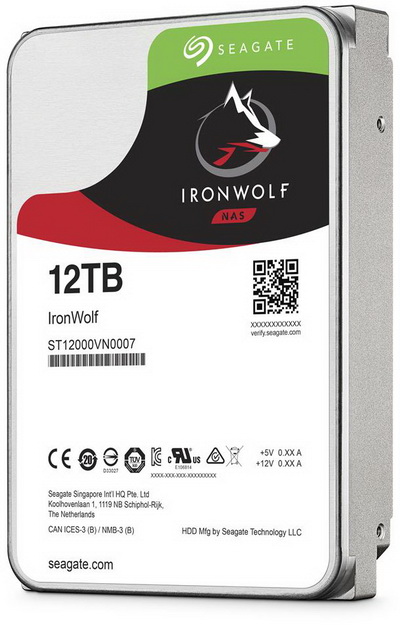
Looking at all the hard disk drives to arrive in our lab lately i still can't believe that at one time we thought that we'd never need a drive with a capacity of over 500MB. Things changed since then in many ways so today we need 500MB of storage space just to store our graphics card drivers. Competition is almost always a good thing cause it makes companies strive to become even better in order to surpass their rivals and so slightly over a year since Seagate, WD, HGST and Toshiba introduced their first 10TB 3.5 inch hard disk drives already the first 12TB models have made their appearance in the market with 14TB ones announced with projected availability before the end of the year. Once again Seagate was kind enough to send over their new 12TB models at launch and so we'll start reviewing their 12TB line with the IronWolf 12TB NAS Hard Disk Drive.
Founded in 1979, Seagate is the leading provider of hard drives and storage solutions. From the videos, music and documents we share with friends and family on social networks, to servers that form the backbone of enterprise data centers and cloud-based computing, to desktop and notebook computers that fuel our personal productivity, Seagate products help more people store, share and protect their valuable digital content. Seagate offers the industry’s broadest portfolio of hard disk drives, solid-state drives and solid-state hybrid drives. In addition, the company offers an extensive line of retail storage products for consumers and small businesses, along with data-recovery services for any brand of hard drive and digital media type. Seagate employs more than 50,000 people around the world.
With the new 12TB model the IronWolf line of HDDs by Seagate is now currently available in 1/2/3/4/6/8/10/12TB capacities and is optimized for use with up to 8 bay network attached storage devices, desktop servers and private cloud storage. Just like the 10TB variant the brand new 12TB model also features Seagate's AgileArray technology (includes dual-plane balancing, RAID optimization and advanced power management), Rotational Vibration (RV) mitigation (several RV sensors help maintain high performance in multi-drive NAS enclosures) and Error Recovery Control. The IronWolf 12TB drive also features a total of 8 platters (1.5TB each), spins at 7200RPM (1/2/3/4TB models spin at 5900RPM while 6/8/10/12TB models spin at 7200RPM), has a total of 256MB cache (1/2/3/4TB models have 64MB while the 6TB model has 128MB and the 8/10/12TB models have 256MB) and comes with the typical SATA 6Gb/s interface. Just like the 10TB model the 12TB one is rated for up to 180TB per year (multi-user technology), has an MTBF (mean time between failures) of 1 million hours and is covered by a 3 year limited warranty.
SPECIFICATIONS AND FEATURES

THE IRONWOLF 12TB
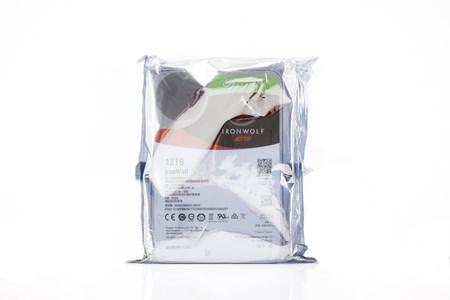 The IronWolf 12TB arrived inside a sealed static free bag (bulk).
The IronWolf 12TB arrived inside a sealed static free bag (bulk).
 Nothing new in terms of appearance since the new IronWolf 12TB model is identical to the 10TB model.
Nothing new in terms of appearance since the new IronWolf 12TB model is identical to the 10TB model.
This time over however the sticker at the top of the drive contains the usual information such as the drives serial number, factory roll-out date, interface, capacity, electrical requirements and installed firmware.
 As usual at the rear we see a small PCB with all the modules placed on the other side for increased protection (we also see the same empty spot on the upper right corner which may one day be used for extra cache (or an SSHD model).
As usual at the rear we see a small PCB with all the modules placed on the other side for increased protection (we also see the same empty spot on the upper right corner which may one day be used for extra cache (or an SSHD model).
Four pins (probably used for firmware updates) and the usual SATA power and data connectors are located at the rear of the drive.
TEST BED


TESTING METHODOLOGY
Thoroughly testing hard disk drives may require time and patience but that's just about it. Of course that doesn't mean that one must take it lightly, at least not when people base their decision on your results. True some choose to only use 2 or 3 benchmarking suits in order to measure the performance of a drive or drives since quite honestly most benchmarking suites do tend to agree with each other (so it's not really wrong) but we always like to take things a step further not because we have to but because we want to be almost 100% certain of the results we get and post in our charts.
So in this kind of reviews we will use a total of 7 different benchmarking suites in an effort to bring you the most accurate results across the board. Now the only reason why i say effort is because real-world usage is not always on par with what results one gets by running several benchmarks on a drive and that's mainly because there are many variables at work from ambient temperatures to hardware configurations and even firmware versions. The benchmarking applications we use are the AIDA64 suite (former Everest Pro), HD Tune Professional (as of October 2016 we also record seek times of 3.5” drives), HD Tach RW, ATTO, Sisoftware Sandra Pro, Crystal Disk Mark 64bit and the PCMARK 7 (secondary storage suite). These benchmarking tools are the best in what they do and as you will also see later on their results more or less agree. Each test is performed a total of 6 times and then the average is recorded into the charts. Temperatures are recorded using Hard Disk Sentinel and after 45 minutes of continuous testing in a 23 degrees Celsius temperature controlled room. Finally we also use an ExTech HD600 dBA meter on each of the drives (5cm away) in order to accurately record their noise levels (during access), although if you don't turn off all system fans when doing so it's quite possible that you will never even hear the drive. The operating system as usual is a fresh installation of Microsoft Windows 7 Ultimate Service Pack 1 with every update installed up until the 10th of October 2017.
TEST RESULTS - AIDA64 / ATTO
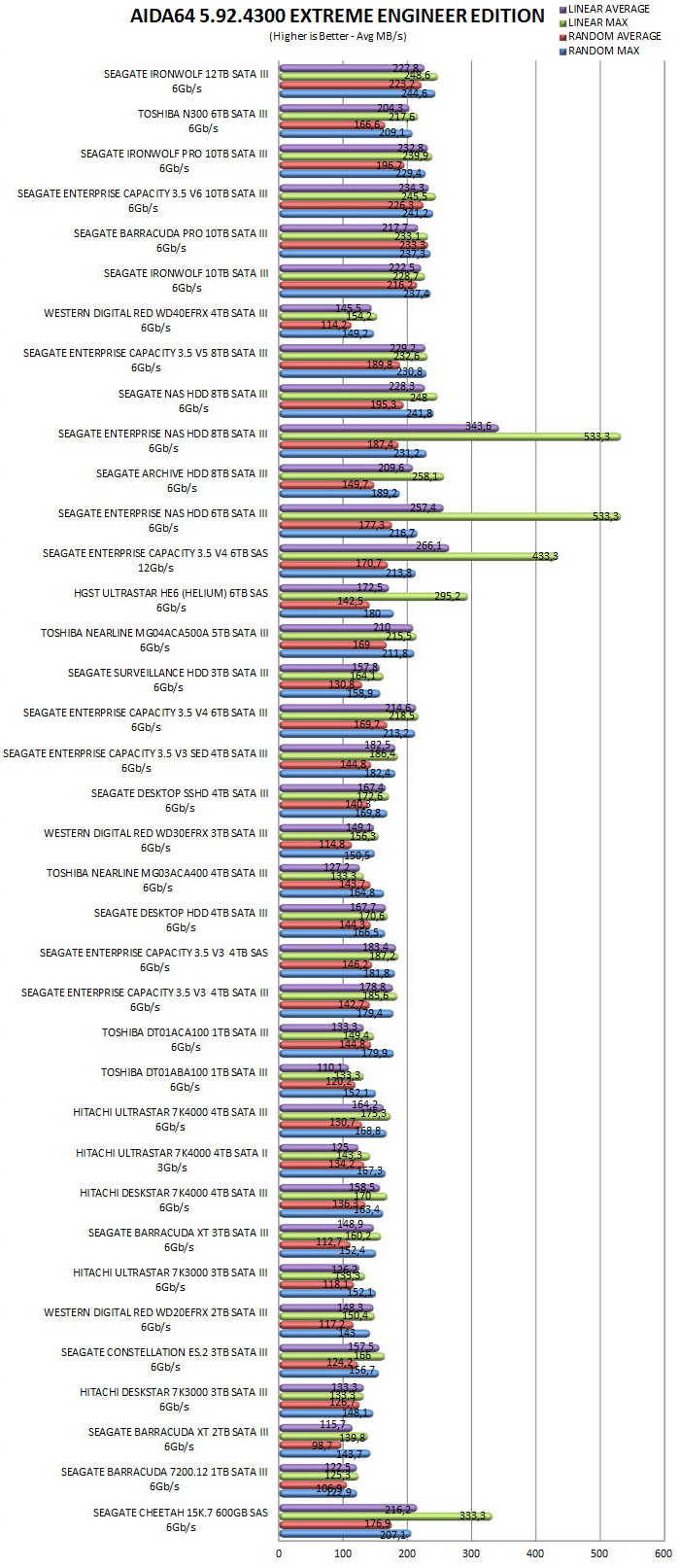

TEST RESULTS - HD TACH RW / HD TUNE PRO
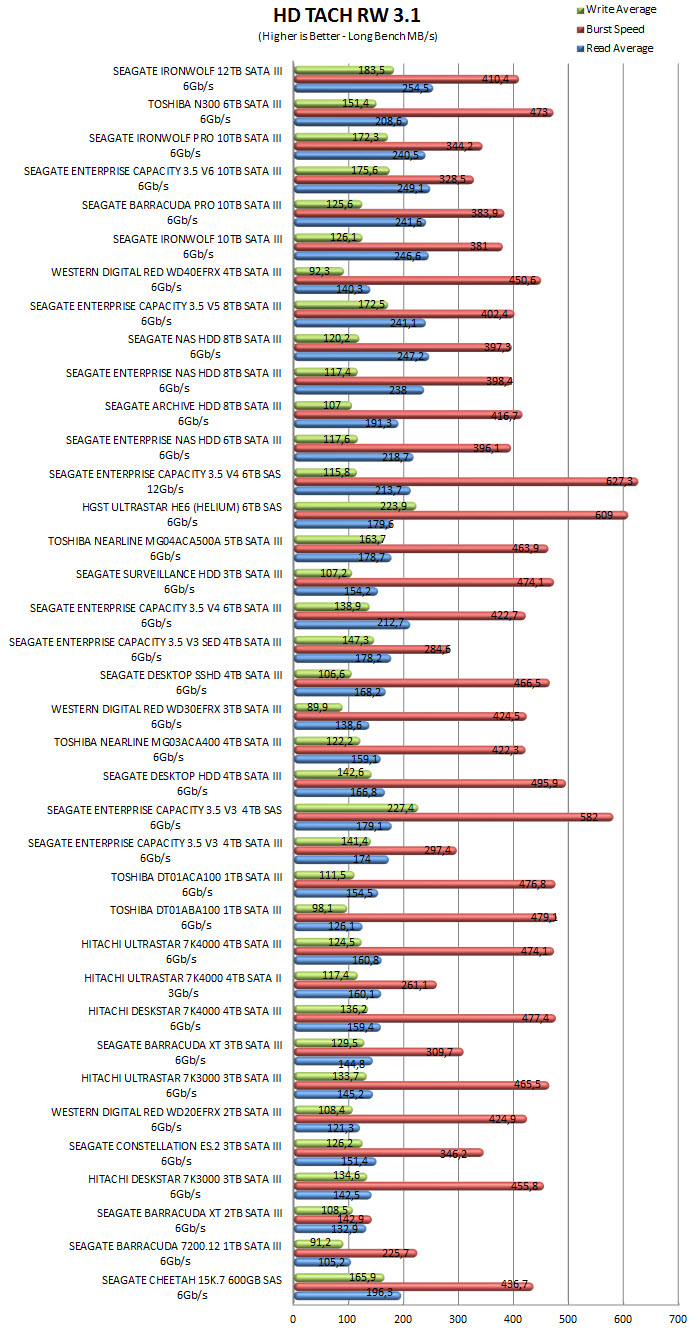


TEST RESULTS - SISOFTWARE SANDRA PRO / CRYSTAL DISK MARK X64


TEST RESULTS – PCMARK 7 / TEMPERATURES / NOISE LEVELS



CONCLUSION
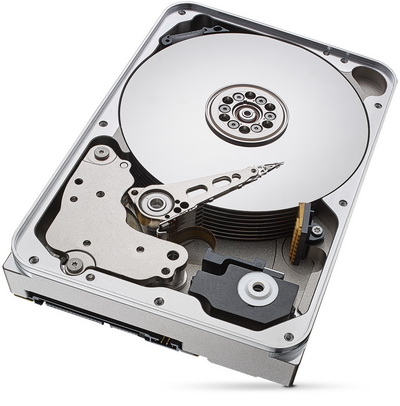
Although using more platters could result in reduced performance levels the exact opposite has been happening for quite some time now and thus the new IronWolf 12TB hard disk drive is the fastest overall SATA model in our charts. True the performance gap compared to the 10TB model is far from large but it’s there and getting a faster drive is never a bad thing. Leaving out however the 2TB increase in capacity thanks to the extra platter everything else however remains the same including its endurance numbers (180TB/y – 1m MTBF), rotational speed (7200RPM) and cache (256MB). Perhaps what’s more interesting is that Seagate will be releasing a 14TB variant really soon so we can’t wait to see if that model will produce even higher read and write performance numbers.
Whenever a manufacturer breaks the current storage capacity ceiling by introducing a new model prices are naturally set quite high and this is partially true with the IronWolf 12TB HDD since it currently retails for USD479.98 inside the USA (Amazon.com) and for 412Euros inside the EU (Amazon.co.uk). Now the reason I wrote partially is because the 10TB variant had a higher price tag attached to it at launch so getting 2TB more for the same amount of money (and less) is certainly a good thing. All said and done not only does the IronWolf 12TB model offer 20% higher capacity compared to its predecessor but it’s also faster and priced more aggressively so it’s definitely worth our Platinum Award.

PROS
- Build Quality (180WRL / 1 Million Hours MTBF)
- Top Of The Charts Performance (SATA)
- 256MB Cache
- 12TB's Capacity
- Temperatures / Noise Levels / Power Consumption
- Enclosure Material (Low Temperatures)
- 3 Year Limited Warranty
CONS
- Price (For Some)

 O-Sense
O-Sense









.png)

